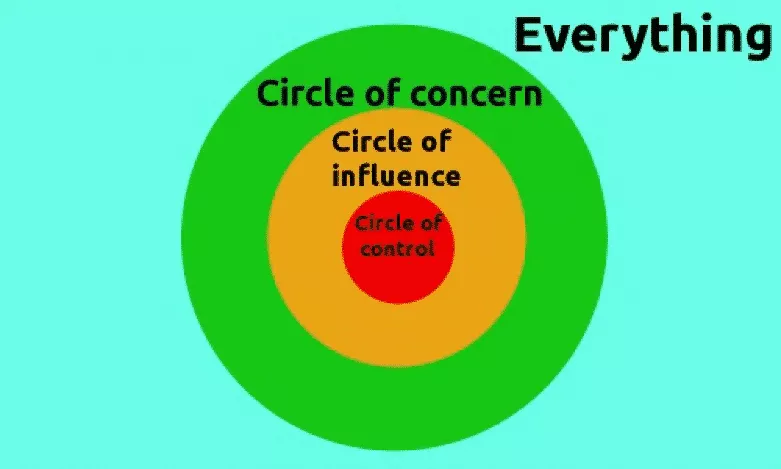Why you should re-read the ‘Circle of Influence/Circle of Concern’ Model right now….

I bet when Stephen Covey came up with the Circle of Influence/Circle of Control model in his bestselling book, The 7 Habits of Highly Effective People, he didn’t imagine that it would also be incredibly relevant to a world facing COVID-19.
But it is.
And it’s a useful model to revisit right now – not just for leaders, but for everyone.

First though, here’s the premise of the model:
There are three main areas you can spend your energy on - your Circle of Concern, your Circle of Influence and your Circle of Control. According to Covey, highly effective people spend far more energy focusing on their Circle of Influence and Circle of Control than on their Circle of Concern. In a nutshell, the main point of the model is that instead of spending a lot of teeth gnashing on the things that simply concern or worry us, but which we have no control over, we should spend our time and energy on the things we have influence over or can control.
So what falls into each circle?
Our Circle of Concern will be things which we think about, worry about and which concern us, but which we have no direct influence over. For instance, if we apply this idea to COVID-19, our concern may be about the impact and rate the virus is spreading around the globe and the potential consequences of this. We may be worried about it, but our ability to change this rate as an individual at a global level may be limited (unless of course, you’re a leader of a country).
Our Circle of Influence, on the other hand, encompasses those concerns which we can realistically do something about. They’re the things which we can influence, although we may not have direct control over the end outcome. For example, we could use our role as a leader within our organisation to influence our team members to follow the recommendations of trusted sources - like the Ministry of Health here in Aotearoa New Zealand. We can model compassion and care during a challenging time. We can lead effectively through challenging times, like I outline in this blog.
In essence, our Circle of Influence consists of concerns which we have some control over.
But wait – there’s a third, smaller circle in the middle of the two above, and that’s where the magic lies in troublesome times like these.
Nestled inside the above two circles is a smaller circle. This is your Circle of Control.
This sphere consists of things that are within your control, namely…
- How you engage with troubling thought patterns you might experience
- The way you react to external stimuli
- The actions you take, the words you use and the way you ‘show up’ as a leader in times of crisis
As a leader, you many not feel as though you are always entirely in control of these things – your thoughts especially - although practicing mindfulness and cognitive behaviour therapy can help with challenging or unhelpful thoughts. The vast majority of the time, you have the most control over these things in comparison to the other two circles.
If we apply this to COVID-19, things within our Circle of Control include whether we wash our hands often, following the Ministry of Health's Alert Level requirements and using socially distanced greetings (like the East Cove Wave).
It definitely includes looking out for one another during this challenging time and practicing compassion and cooperation.
Although we may forget it sometimes, other people’s actions, other people’s thoughts, and even the environment directly around us may be able to be influenced by us, but we never, ever control them. Confusing influence and control can lead to all sorts of anxiety and hand wringing.
Do you spend a sizeable chunk of your time and energy outside your circle of influence? If you do, here are two good options:
- Focus your attention elsewhere
- Focus your attention on those issues in a way that puts them in your Circle of Control or Circle of Influence.
Whenever you find yourself feeling anxious (which is understandable in these current times), try asking yourself: “What is within my control in this situation? What small, proactive or positive thing can I do to respond?”
Figure out some good ideas and act on them. If you really can’t think of anything, try redirecting your energy, thinking and resources to an area where you can actually make a positive, compassionate difference, no matter how small.
As you lead yourself and your team through these stormy waters, remember Covey’s model and spend your time and energy within your Circle of Influence or Circle of Control, while encouraging others to do the same.
Speaking of the Circle of Control, you could share this blog post with your team or colleagues!





6 Comments
Love this and your practical insights. Thank you Suzi for sharing! You rock!
Thanks Jayne. You rock.
Hi Suzie
I am just catching up on mail - I really deeply appreciate this in particular and in fact all your posts.
I plan to use this as I begin to work on some future visioning for my team - as you point out - quite difficult when one is dependent upon govt/ministry directives as well as when our schools will be back in full or part and what that may look like in hopefully a 'new' world.
You are so good for the heart/soul and then for leadership!! A true star thank you so much!
Hi Suzi I’m new to this Circle of Concern , in fact I’ve been recently requested to read about by my middle son. Just reading what you’ve written, I’m already intrigue and want to learn so much more.
A big thank you.
Hi Suzi, this Gemma, I’ve just looked up my Sons email, and your name was right there. So thank you.
Dearest Suzi, thank you for sharing your #fridayfind, a great lockdown find for skimming over with my coffee this morning. That book has been on my hit list and you’ve got me inspired to download for my next lockdown read. Thank you for always being so inspiring. Take care Diana Kxx
Leave a comment